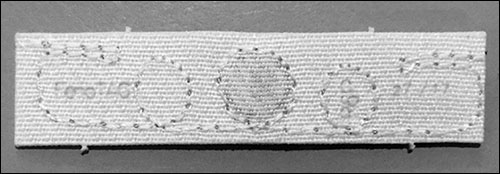Two French technology companies have developed a small, high-power, textile UHF RFID tag for use in linens and uniforms, designed to be unobtrusive and unlikely to be folded. UBI Solutions is selling the tag, provided by Fenotag as part of its laundry and hospitality solutions for customers throughout Europe.
The passive UHF UbiTEX 1358 textile tag offers a read range up to 5 meters (16.4 feet), with a small footprint—it measures 13 millimeters by 58 millimeters (0.5 inch by 2.3 inches), is 0.5 millimeter (0.02 inch) in thickness with the exception of the chip area, and is designed to be used in spaces RFID tags previously would not fit. The tags come with a built-in Impinj Monza R6-P chip.
When it comes to technology for hospitality and health care, says Renaud Munier, UBI Solutions’ business-development director, “The industry is always looking for smaller tags.” Most textile-based UHF RFID tags can be sewn into or glued to linens, such as towels and table cloths, but are more difficult to attach to very small items, like some garments, pillow cases and napkins. They are also often visible to those handling the linens due to their size. In addition, Munier says, large tags are often folded when a garment or other linen is washed and folded, which can make the tags difficult to read.
UBI Solutions recently began working with Fenotag to develop a tag that would be small enough to fit on previously untagged items, would be unobtrusive and aesthetically pleasing, and would be unlikely to be folded. Fenotag, Munier says, is not only located in France along with UBI Solutions, but manufactures its products in-house, which makes production more flexible. If a specific material or size is required, the company can accommodate, he says, adding, “We worked with different suppliers, then we decided to partner with Fenotag” to create a smaller tag that can be read well at any orientation and would be unlikely to be folded.
Most textile tag manufacturers sell textile tags measuring 60 to 80 millimeters (2.4 to 3.1 inches), says Didier Elbaz, Fenotag’s president. UBI Solutions asked Fenotag to reduce both width and length in order to lower the risk of having a tag folded with linens, thus significantly decreasing reading performance. But the company also wanted better read performance. “They asked me to increase the reading-writing performance even if the size was reduced, which was really a big challenge,” Elbaz says. “The target was to have a reading performance higher than 5 meters in the European and U.S. bandwidth [UHF].”
The laundry environment poses unique challenges in terms of performance, since between 400 and 1,000 linens are typically interrogated simultaneously while stacked or thrown into a trolley or cart. Such a high density can result in a tag being detuned, Elbaz says. “With our tag, the Impinj Monza 6RP chip, and the hardware—the system from UBI Solutions—we have been able to achieve the ‘holy grail’: a reading rate close to 99 to 100 percent and good reliability.”
The R6-P chip enables some of that functionality, according to the company. Its AutoTune feature ensures that the tags can be read effectively in the presence of liquids, such as in wet towels or dirty laundry. The severity of that effect varies depending on the material. Wet towels can be much harder on tag reads than, for example, cardboard, says Carl Brasek, Impinj’s senior director of silicon product management. AutoTune automatically recalibrates the tag chip “to compensate for any impact to the antenna tuning,” he explains.
It also offers Enduro pads—metal pads that provide a durable connection between the chip and the antenna—specifically designed for harsh applications like laundry. The Enduro pads create a more uniform surface area, Brasek says, “meaning these chips are less prone to breakage or cracking than chips that use bumps as an antenna connection method.” With Integra data diagnostics, the system offers a memory check to make sure the tag has been properly written, and provides an ongoing diagnostic check ensure that the tag has not been damaged in the laundry environment.
The tag consists of a Monza R6 chip and a small primer antenna built into what Elbaz calls a hard tag, with an electromagnetic coupling to a secondary antenna composed of a flexible thread. The tag is designed to be easily sewn onto the edge of an item and can withstand heat-sealing processes, so it can also be attached via adhesive. Moreover, Munier says, the tag enables a serial number to be laser-printed onto it so that users can visually identify it when needed.
Several companies are currently beta-testing the new tag, Munier says, and although he declines to name those businesses, he says they are in the hospitality and health-care sectors. Typically, tags are being attached to linens and towels along the hem, where they are difficult to detect. They are then put through the typical use case: used by patients, guests or employees of a company, then sent to laundry services. The tags are read automatically via fixed RFID readers built into chutes, laundry receiving areas or portals. Handheld readers can also be used by employees who receive, distribute or ship out the laundered or unlaundered items.
UBI Solutions’ UBI Cloud software captures each tag ID read and manages that data, making it available for users to view where and when goods have moved through specific areas. This information helps hotels or hospitals to understand when they may be running low on specific inventory, as well as carry out billing or replenishment. For laundry service providers, the technology can help them to manage the movements of goods through their own facilities, or view when a customer may require a pickup if that customer is sharing RFID-based data with the service provider.
Fenotag will sell its own version of the new tag as the FenoTEX-1358R6P. “For Fenotag,” Elbaz says, “there is always a new demand with a new market approach and a challenge to take up. Our strength is to be able to manage RF design internally,” including the antenna, the material used, the packaging, and cosmetic and personalization design specifications. The manufacturing is accomplished at the same site in France.
“This tag is only [one] step forward for the textile RFID industry,” Elbaz states. “Many other steps are already in our hands,” he says, and the company intends to propose other innovations in the future.




